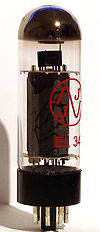EL34
The EL34 electron tube is a pentode that is used in the output stages of audio amplifiers such as guitar amplifiers .
history
The development of the EL34 goes back to the time before the Second World War via various predecessor types. The EL60 , for example, is a forerunner introduced by Philips / Valvo, which only differs from it in the use of a 9-pin local socket instead of the octal socket.
The first examples with the designation EL34 appeared in 1949. Initially often used in mixing amplifiers of medium power, it became known worldwide from around 1968 through the Marshall guitar amplifiers often used in rock music . European companies like Philips or Telefunken stopped production years ago. In the North American area, the tube was manufactured as the 6CA7 by General Electric and RCA .
There were also various similar replicas of this pentode, such as the KT77 , which is currently being manufactured again in Slovakia. Even companies such as the Russian Svetlana Tubes or the Slovak tube manufacturer JJ Electronic still have this end pentode under the name EL34 in their delivery program in 2006 from a new production.
There is also at least one series with a Siemens label, which instead of the conventional pentode design with a braking grille are constructed as beam pentodes (so-called beam power design) and have a radiation plate (see photo). These are fully interchangeable with the normal brake grid variant.
use
The tube is often used in stage amplifiers for electric guitars. The single-beat A mode is particularly interesting here, as it leads to characteristic distortions typical of this type of music at full or slightly overdriven.
The EL34 is also in the final stages of many hi-fi - tube amplifier under its tonal qualities often used both because of and because of their ability to comparatively high output powers.
Technical specifications
In the tube designation EL34 : E - 6.3 V heating voltage, L - power pentode; the 3 stands for the socket type (octal socket) and the 4 is a consecutive number. The American name for this tube is 6CA7 . In Russian it is called 6P27S ( Cyrillic : 6П27C ) The current consumption of the indirect heating is 1.5 A, the maximum anode power loss is 25 watts and the screen grid power loss is 8 watts.
With an EL34, an output of 11 watts can be achieved as a class A amplifier . Two EL34s achieve 34 watts as push-pull AB amplifiers and 100 watts as push-pull B amplifiers (800 V operating voltage, 5% distortion factor ).
The operating parameters of such a class A amplifier (1 tube) are according to Valvo data sheet 1965:
- Anode voltage / screen grid voltage: 265 V
- Anode current: 100 mA
- Screen grid current: 14.9 mA
- Total harmonic distortion (11 watt output power): 10%
- Working resistance ( output transformer coupling to loudspeaker): 2 kOhm
literature
- The first mention in a monograph of the primary literature can be found in: BG Dammers u. a .: Application of the electron tube. Book 2. 1951 Eindhoven, NV Philips 'Gloeilampenfabrieken, from the series of books on electron tubes Philips' Technical Library (see there p. 130ff EL34 switched as a triode, also an oscilloscope image of the characteristics).
- Ludwig Ratheiser: Tube and transistor manual . 3rd edition, Technischer Verlag Ing. Walter Erb, Vienna 1964, p. 180f with 12 characteristic diagrams and 12 circuit diagrams.
Web links
- Data Sheets
- Data sheet of the EL34 from Svetlana Tubes
- Data sheet of the EL34 from JJ Electronic (PDF; 200 kB)
- EL34 variants shown and explained in detail
- The history of the EL 34
Individual evidence
- ↑ VALVO tubular pocket book 1965, p. 101.



